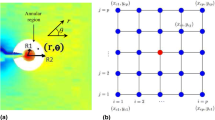Abstract
Stress analysis of engineering artifacts and structures is a routine and essential component of the design process that is often performed using computation tools. Such tools require verification using experimental data and for complex structures the stress analysis must be validated via experiment. In addition to its applicability for assessing the reliability of other solutions, thermoplastic stress analysis (TSA) can be used to analyze cases for which other methods are difficult not feasible. The technique is based on the small temperature changes that occur when a material is subject to a time-varying strain. In thermoelastic stress analysis, it is common practice to employ cyclic loading and to measure the resultant temperature changes using an infrared sensor or camera. For an isotropic material under plane stress, the relationship between the principal stresses, σp and σq and the signal generated by the sensor, S* can be simplified to
where K is the thermoelastic coefficient. Equation (1) suggests neither a state of pure shear stress nor static stresses produces any thermoelastic response for an isotropic material. Interpretation of thermoelastic stress analysis signals can therefore require some insight based on the loading and geometry of the component being analyzed. For zero mean stresses, Eq. (1) provides isopachic information and therefore locates the center of Mohr’s circle. If there is non-zero proportional cyclic loading about some mean stress, TSA provides only the change in isopachic stress. Under orthotropy, S* depends on a linear combination of the changes in normal stresses in the directions of material symmetry. Thermoelastic stress analysis methods have been developed to smooth measured temperature data, formulate approaches for three-dimensional components and to obtain individual components of stress (or strain) in isotropic and orthotropic composite materials. This paper reviews these methods, provides an update on progress and highlights the areas where further research is needed.
Access this chapter
Tax calculation will be finalised at checkout
Purchases are for personal use only
Similar content being viewed by others
Author information
Authors and Affiliations
Editor information
Editors and Affiliations
Rights and permissions
Copyright information
© 2007 Springer
About this paper
Cite this paper
Patterson, E.A., Rowlands, R.E. (2007). Stress Separation Using Thermoelastic Data. In: Gdoutos, E.E. (eds) Experimental Analysis of Nano and Engineering Materials and Structures. Springer, Dordrecht. https://doi.org/10.1007/978-1-4020-6239-1_420
Download citation
DOI: https://doi.org/10.1007/978-1-4020-6239-1_420
Publisher Name: Springer, Dordrecht
Print ISBN: 978-1-4020-6238-4
Online ISBN: 978-1-4020-6239-1
eBook Packages: EngineeringEngineering (R0)



